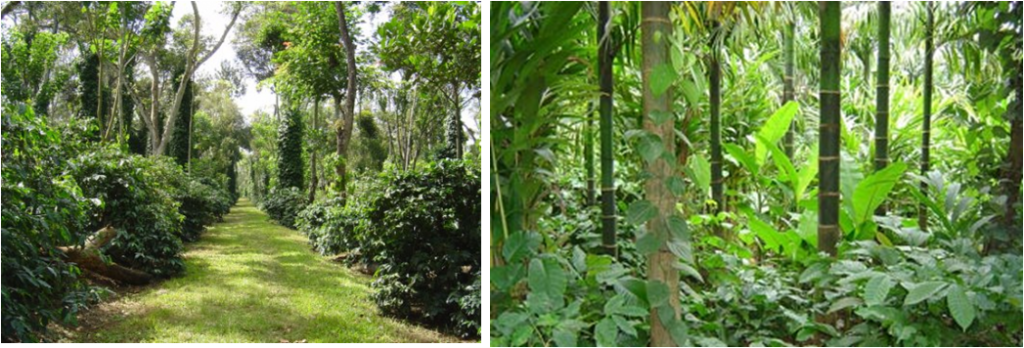Dr. Anand Pereira and his wife, Geeta Pereira, own and run a model coffee farm called “Joe’s Sustainable Coffee Plantation” on the foothills of the Western Ghats in India – a UNESCO World Heritage Site and one of the eight “hottest hotspots” of biological diversity in the world with over 5000 species of flowering plants, 139 mammal species, 508 bird species and 179 amphibian species.
Anand and Geeta’s website has numerous articles and illustrations of their coffee farm and the fauna and flora of the Western Ghats.

Inauguration of the state-of-the-art energy-efficient sprinkler systems, with the Chairman of the Indian Coffee Board (centre) as the chief guest. Anand and Geeta Pereira are on the right of the picture.
Their goal is to protect this rare habitat and they have worked diligently on sustainable technologies for the past 25 years to develop a practical and sustainable system that can greatly benefit other coffee farmers. This includes rainwater harvesting techniques using their ‘rain gun sprinkler system’, the use of biofertilizers including azolla, and the integration of multiple complementary crops including coffee, areca nut, pepper, banana, ginger, orange and rice.
Their ‘shade grown coffee’ farm has become a model for both Indian and foreign farmers, with many visiting the farm to seek technical help in setting up their own coffee estates.
Biofertilizers
“We invested huge sums of money in building up the soil organic matter content with application of different types of farm yard manures. Over the years, the build-up of organic matter with help of compost, nitrogen fixing microbes and introduction of leguminous plants helped in the retention of soil moisture.”
Anand and Geeta’s January 2003 article ‘Bio-fertilizers for Coffee Plantations’ provides a detailed analysis of the benefits of biofertilizers compared to those of chemical fertilizers, and reached the same conclusion to those independently discussed on our Foundation web page.
Their analysis of the nitrogen content of organic fertilizers also demonstrated the ability of both Neem Cake and azolla to provide high amounts of this essential macronutrient:
|
ORGANIC MANURES |
% NITROGEN CONTENT |
| FARM YARD MANURE | 1.0-1.5 |
| BONE MEAL STEAMED | 1.5-2.5 |
| SEWAGE & SLUDGE | 3.5-4.0 |
| NEEM CAKE | 3.0-3.5 |
| COFFEE HUSK | 1.0-1.5 |
| STRAW | 0.5-1.0 |
| NIGHT SOIL | 1.0-1.2 |
| POULTRY MANURE | 2.0-3.0 |
| CATTLE MANURE | 0.7-1.5 |
| SHEEP & GOAT | 2.0-2.75 |
| FISH MEAL, BONE MEAL, BLOOD MEAL | 1.0-2.5 |
| TANK SILT | 0.3-0.5 |
| SUGARCANE PRESS MUD | 0.3-0.5 |
| AZOLLA | 3.0-4.0 |
| VERMI-COMPOST | 1.0-1.5 |
Azolla and coffee
Based on these results, Anand and Geeta have worked extensively with azolla for over a decade, collecting strains from different coffee growing regions to select those with the highest nitrogen-fixing efficiency.
In Anand’s own words:
”I was so fascinated with the azolla fern that I opted to do my MSc. in Microbiology specializing in the azolla-anabaena symbiosis. We are largely responsible for popularizing the use of azolla in rice and coffee systems in our area. This wonder fern has tremendous potential for the present as well as for the future of coffee and rice cultivation due to its provision of nitrogen!
Our conviction is strong that azolla is no ordinary fern, and we are only beginning to understand it. Just to give you a practical illustration: Our family owned 300 acres of land, in which 200 acres was planted with coffee and 100 acres was left for rice cultivation. After completing my Masters programme with azolla as my Major, we introduced the fern as a principal component of rice cultivation. The first thing we did was establish an experimental plot by the roadside where the villagers could see for themselves what the fern could do.
Initially, the villagers were very skeptic, but as they saw the azolla mat grow in geometric proportions, they were amazed and convinced that it was no trick, but that there is something special about this remarkable fern. They were surprised that the mat of azolla could choke the weeds and help establish the rice for better productivity. Slowly they enquired and asked us to provide the technology and over the years it became popular in our village.”
Growing coffee and preserving species diversity
Shade grown coffee forests are positioned deep in the heart of the Western Ghats.
The vast majority of shade grown eco-friendly Indian coffee forests are flanked by National Parks and Wildlife Sanctuaries. The Bandipur National Park flanked by Nagarahole National Park, Madhumalai Wildlife Sanctuary and Wayanad Wildlife Sanctuary, together constitute the protected NILGIRI BIOSPHERE RESERVE, which is India’s first biosphere reserve.


The Kudremukh National Park also has the additional status of a Tiger Reserve.

Dr. Anand Titus Pereira and Geeta N. Pereira
Anand and Geeta are Azolla Foundation Associates and Board of Studies Members of St. Aloysius College and St. Agnes College, Mangalore, Karnataka State. Anand is also a Coffee Evaluator and Technical Consultant to the Indian Government’s Canara Bank.
They are regular contributors to INEEDCOFFEE.COM and present lectures on the intrinsic value of shade grown coffee.
Anand Pereira and Geeta have recently published a 600 page book titled “ECOFRIENDLY COFFEE ” which discusses and illustrates the flora and fauna of the Western Ghats in relation to coffee plantations. The book is beautifully illustrated with pictures and flow charts, and it is also featured on our web page.



